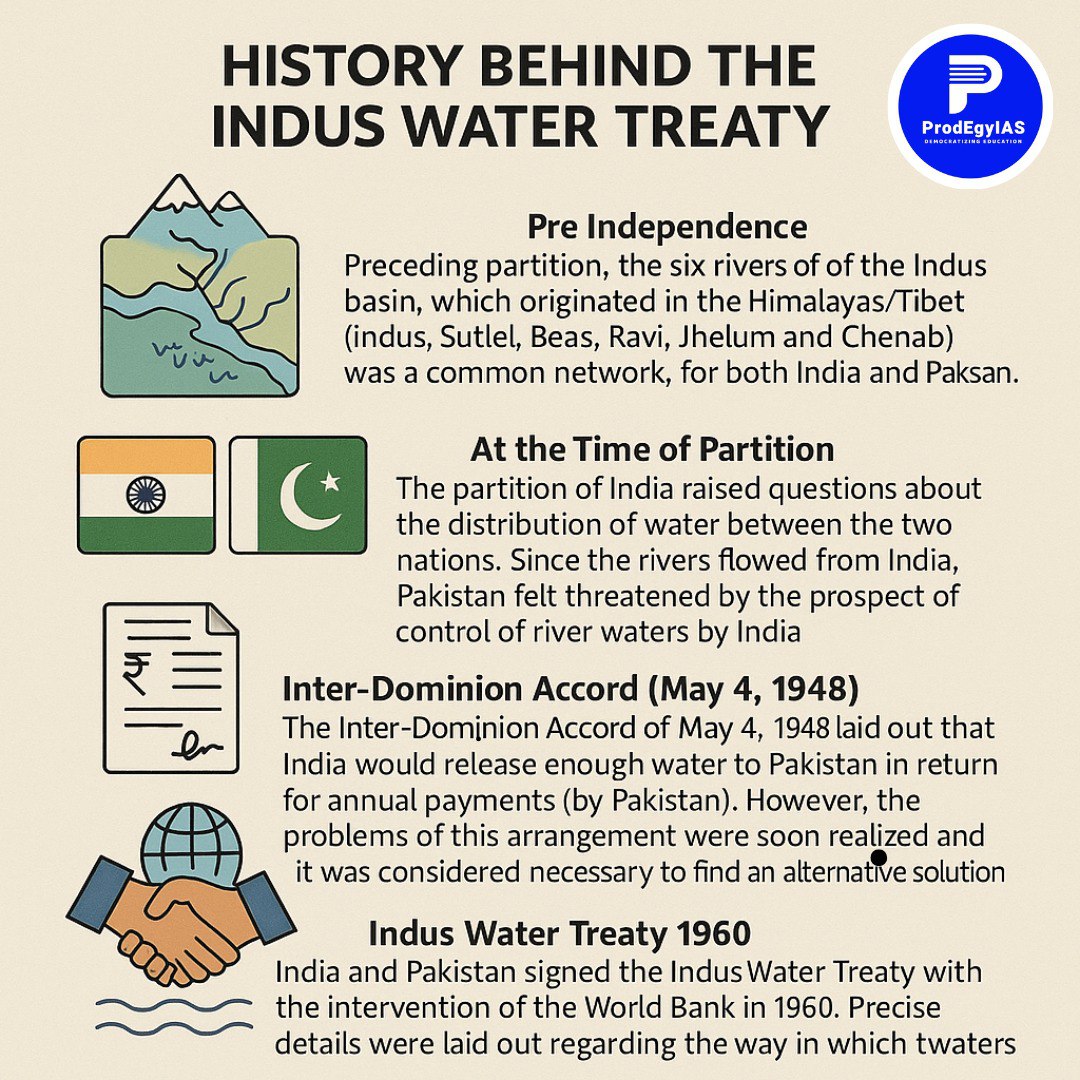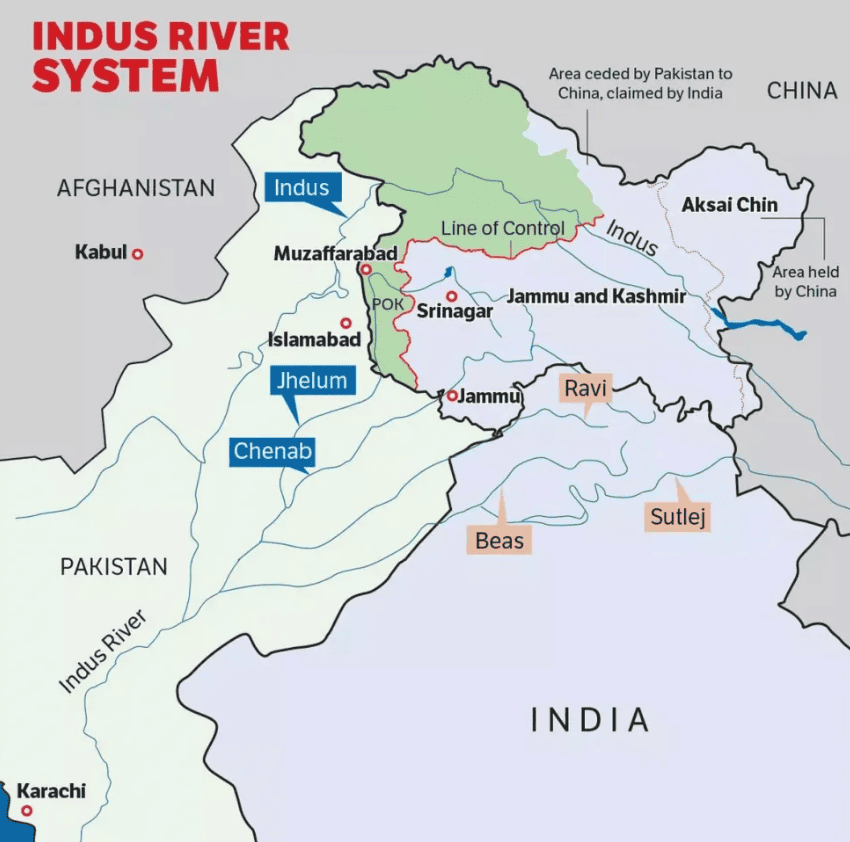Source: The Indian Express
Relevance: GS II – India and its neighbourhood Relations
Why in News:
After the terrorist attack on the tourists in Pahalgam on April 22, India suspended the Indus Water Treaty (IWT) for the first time. The IWT has withstood four wars, decades of cross-border terrorism by Pakistan against India, and a long history of hostility between the two nations.
What is the Indus Water Treaty?
The use of water from rivers that flow downstream from India into the Indus river basin in Pakistan is a point of contention between the nuclear-armed neighbors.
- The Indus Waters Treaty, which was brokered by the World Bank and signed by the neighbors in September 1960, regulates how the water is used.
- The deal controlled water sharing and divided the Indus and its tributaries between the two nations. The Sutlej, Beas, and Ravi rivers in the east were given to India, while the majority of the Indus, Jhelum, and Chenab rivers in the west were given to Pakistan.
- The treaty contains explicit dispute resolution procedures and makes no mention of either party unilaterally suspending or terminating the agreement.

Key Provisions of the Treaty
Conditions for the River Indus and its five tributaries to share water are outlined in the treaty.
- India gained authority over the three rivers in the east, which are: Sutlej, Ravi, Beas.
- India will have unfettered access to all of the Eastern Rivers’ waters unless an undesirable circumstance arises.
- The three western rivers, which are under Pakistani sovereignty, are: Jhelum, Indus, Chenab.
- The United Nations established a Permanent Indus Commission to settle any disagreements over water sharing, along with an arbitration process to settle issues peacefully.
- The pact permits India to use the water from the western rivers for non-consumptive domestic purposes including irrigation, storage, and energy production.
- According to the treaty, Pakistan receives 80% of the water from the Indus River System, while India receives 20%.
- As much as possible, neither India nor Pakistan will cause substantial harm to the other when implementing any flood protection or control plan.
- India and Pakistan have no right to restrict the use of the rivers’ natural routes for the release of floodwaters or other excess water, and neither nation may hold the other accountable for any harm brought on by such use.
Major Controversies and Disputes
There have been problems with the pact, with both parties accusing one another of breaking its provisions.
- Pakistan complained to the World Bank in 2016 about India’s construction of the Kishenganga and Ratle hydroelectric power projects in Jammu & Kashmir. Then, claiming that Pakistan’s concerns were technical and did not necessitate a court of arbitration (because Pakistan had already brought it to an arbitration court), India asked impartial specialists to examine the plants. Following discussions between the two nations about the treaty’s details, the World Bank approved India’s plans.
- After Pakistan protested, the Tulbul project—a navigation lock-cum-control facility at the mouth of the Wular Lake, located on the Jhelum from Anantnag to Srinagar and Baramulla—was put on hold in 1987. The administration just made the decision to revisit this ban without considering the protests in Pakistan.
- The Rann of Kutch in Gujarat, India, is traversed by Pakistan’s Left Bank Outfall Drain (LBOD) project. Without India’s approval, the project was built. Since this violates the IWT, India has raised an objection. Since the lower riparian state is in India, all relevant information must be provided. In the state of Gujarat, flooding is another risk.
- The Departmentally Related Standing Committees on Water Resources study from 2021 states that the Treaty has not taken into consideration contemporary pressing issues including environmental impact assessments, climate change, and global warming. Climate change has had a significant impact on the Indus basin, which NASA identified as the second most over-stressed aquifer in the world in 2015. India wants the pact to be renegotiated and amended in order to support its growing population.
Recent Developments (2022–2025)
India and Pakistan have been at odds over the two hydropower projects in Jammu and Kashmir for years. In January 2023, New Delhi sent a notification to Islamabad asking for “modification” of the Treaty.
- In the more than 60 years that the Treaty has been in effect, this was the first notice of its kind. India issued another warning to Pakistan regarding this issue in September 2024.
- Pakistan takes issue with the two hydroelectric projects’ design elements. Pakistan has consistently claimed that these projects breach the IWT, despite the fact that they are “run-of-the-river” projects, which provide energy without interfering with the river’s natural flow.
- Islamabad’s ongoing “intransigence” in carrying out the Treaty was mentioned by New Delhi in its notification to Pakistan in January 2023.
- New Delhi’s warning from September 2024 called for the IWT to be “reviewed and modified.” Experts claim that the word “review” clearly conveyed India’s intention to withdraw and renegotiate the Treaty.
- Both notifications were sent out in accordance with Article XII(3) of the IWT, which says that “a duly ratified Treaty concluded for that purpose between the two Governments may from time to time modify the provisions of this Treaty.”
- The World Bank’s 2022 Neutral Expert, designated under the IWT, determined in January of this year that he was “competent” to decide on the disagreements between India and Pakistan over the designs of two hydropower projects.
- India halts water delivery to Pakistan and downgrades diplomatic ties after a terrorist incident in Jammu and Kashmir, suspending the Indus Waters Treaty on April 23, 2025.
Way Forward
- The standing committee on water resources recommended that Punjab and Rajasthan’s canal networks be renovated in order to boost their capacity to carry water. India should also take action to fully utilize the Western Rivers’ waters as they are entitled to.
- India’s relations with other regional players, such as China and Afghanistan, who share portions of the Indus basin, may be impacted by the suspension.
- According to the Brisbane Declaration and the 2013 Permanent Court of Arbitration decision on Kishanganga, ecological viewpoints must take Environmental Flows (EF) into account in order to maintain the Indus Valley ecosystems.
Previous Year Question Q. The interlinking of rivers can provide viable solutions to the multi-dimensional inter-related problems of droughts, floods, and interrupted navigation. Critically examine. (2020) |
About the Author: Nitin Kumar Singh |




